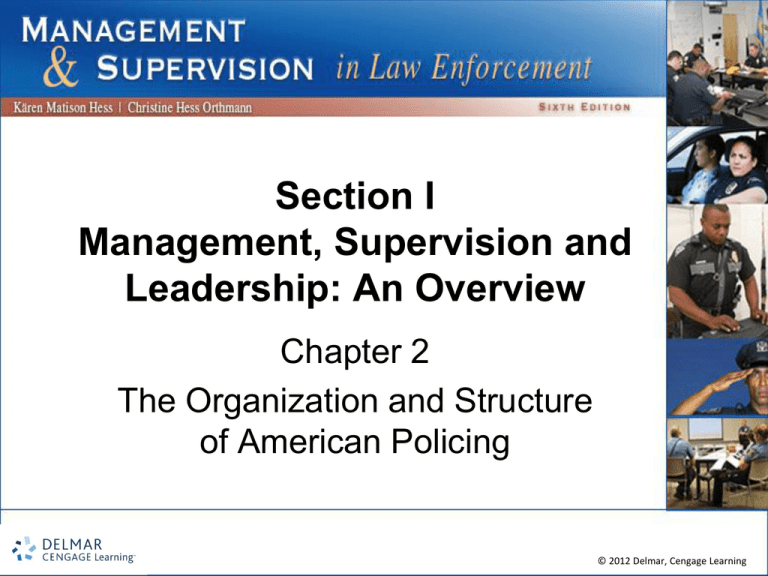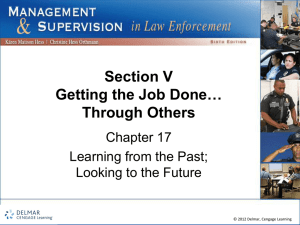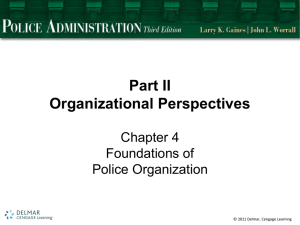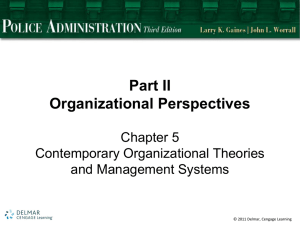Section I Management, Supervision and
advertisement

Section I Management, Supervision and Leadership: An Overview Chapter 2 The Organization and Structure of American Policing © 2012 Delmar, Cengage Learning The Traditional Law Enforcement Organization • • • • A pyramid-shaped hierarchy. Police must be stable, efficient and organized militarily. Police must be under governmental control. The test of police effectiveness is the absence of crime and disorder. • Bureaucracy is the most important feature of modern society. • Eliminating wasted time enhances productivity. © 2012 Delmar, Cengage Learning The Formal Organization • A clear statement of mission, goals, objectives and values • A division of labor among specialists • A rational organization or design • A hierarchy of authority and responsibility © 2012 Delmar, Cengage Learning Typical Divisions in Law Enforcement Agencies • Field Services – Use line personnel – Directly help accomplish departmental goals • Administrative Services – Use staff personnel – Support the line organization © 2012 Delmar, Cengage Learning Chain of Command • Establishes definite lines of authority and channels of communication • Chain of command = the order of authority • Channels of communication = official paths through which orders flow from management to personnel who carry out the orders • Unity of command = every individual has only one supervisor • Span of control = the number of people supervised by one manager © 2012 Delmar, Cengage Learning The Informal Organization • • • • • Operates without official sanctions Influences the agency’s performance May help or harm the agency’s goals May support the organization or cause dissention Exists within any law enforcement agency © 2012 Delmar, Cengage Learning The Emerging Law Enforcement Organization • Flattened organization – Fewer lieutenants and captains – Fewer staff departments and assistants – More sergeants and patrol officers • Decentralized – Puts decision making at the level of the patrol officer • Employees are empowered. © 2012 Delmar, Cengage Learning Post–9/11 Policing • Transactional change – Intervenes in structure, management practices and motivations – Unlikely to affect the organization’s mission and culture • Transformational change – Intervenes in an organization’s mission, culture and leadership style © 2012 Delmar, Cengage Learning Organizational Approaches in Contemporary Policing • • • • • Community policing Problem-solving policing CompStat policing Intelligence-led policing Evidence-based policing © 2012 Delmar, Cengage Learning Community Policing • Supports the use of partnership and problemsolving techniques to proactively address conditions that cause public safety issues • Partnerships and problem solving • Police are not alone in accomplishing core functions. © 2012 Delmar, Cengage Learning Problem-Solving Policing • Focus on determining the underlying causes of crime, fear of crime and disorder and identifying solutions • Identify, analyze and respond to underlying circumstances that create incidents • Emphasis on strategy distinguishes POP from COP • Requires police to group incidents as a way to identify causes of problems in the community • Reliance on the expertise and creativity of line officers • Closer involvement with the public © 2012 Delmar, Cengage Learning CompStat Policing • A method of management accountability and a philosophy of crime control • Four principles of CompStat: – – – – Accurate and timely intelligence: know what is happening. Effective tactics: have a plan. Rapid deployment: do it quickly. Relentless follow-up and assessment: if it works do more, if not, do something else. • You can’t manage what they don’t measure. • Helps draw sharp attention to problem areas • Puts facts in place of impressions © 2012 Delmar, Cengage Learning Intelligence-Led Policing • Methodical approach to preventing, detecting and disrupting crime, including terrorist activities • Business model and managerial philosophy • Fusion centers collect, integrate, evaluate, analyze and disseminate information. © 2012 Delmar, Cengage Learning Evidence-Based Policing • • • • Monitoring and evaluating program outcomes Analyzing whether it makes a difference Making adjustments to improve outcomes Includes training, innovation, efficiency, fiscal responsibility and ongoing communication – Partnering with colleges or universities – Reporting failure © 2012 Delmar, Cengage Learning The Impact of Contemporary Policing Approaches on the New Supervisor or Manager • • • • Supervisors and subordinates share power. Supervisors must accept constructive criticism and failure. Supervisors must serve as mentor, motivator, and facilitator. Supervisors need solid set of technological, analytical and time management skills. • First-line supervisors must be more engaged in day-to-day officer performance. © 2012 Delmar, Cengage Learning







